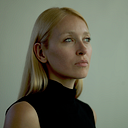Proprioception as a Tool for Empathy in VR
Exploring Industry’s Insights to Make the Future of Immersion in Museums.
[In this new series of article, I’ll share precious insights from key actors of the immersion + museum field to understand the underlying foundations of it all.]
The power of technology to change one’s intellectual viewpoint is one of its greatest contributions, not merely to knowledge, but to something even more important: understanding … it goes beyond the limits of human perception. Arthur C. Clark, Technology and the Limits of Knowledge
Truly understanding someone is not a question of knowledge or facts. It is by experiencing the same emotional and sensorial state that full empathy occurs.
In a panel discussion organised during Museum Connections 2020 in Paris (listen to the podcast here), Karim Ben Khelifa underlined the importance of moving with your own body and making a choice to start interacting with someone. The fact that visitors should move freely in space and decide if they would like to speak with a soldier from Gaza or Israel change the experience from passive to active, and emotional.
The narration of the VR project “The Enemy” is experiential. It is set in very common white walls museum space giving you this feeling of security as if you have been in this space already. In “The Enemy”, you are not going in war zones, but what you will experience will be even more transformative than visual and sound immersion.
To start with, you have to choose who you would like to talk to and direct yourself toward him. When you get closer, the soldier starts to look at you, directly in the eyes, and start a discussion. If you move around or away from him, he will follow you with his eyes, keep talking to you and then let you go while you become too far. In “The Enemy” you become “a passenger” as Karim used to call the VR users, and you start encountering soldiers from Maras of El Salvador, the Democratic Republic of Congo, and Israel and Palestine.
At the same roundtable at Museum Connections in January 2020 in Paris, Fabien Barati from Emissive started to explain how much VR is a medium by itself, allowing new types of narrations (listen to the podcast here).
According to him, the biggest innovation in VR lays in the proprioception. It is the ability to use your body like in real life but in virtual reality. No need to learn new movements or behaviours, just using the knowledge of our own body makes you understand things. Being able to move freely in a physical space is key to create impactful stories.
Today it is already possible to interact virtually in a physical space with other people with whom we are sharing the same space, Fabien explained, as well as with people elsewhere. The challenges are still in the quality of the images, the sound and the tactile and olfactive interactions. But to go further, we need to go away from the backpack with HD autonomous headsets. The next step will even be to use “edge computing” with computers being installed on the side of the room which can send the data via 5G. Another option will be via cloud computing to make the distribution of the VR experience simpler while just connecting the VR headsets to the computers based in the company’s office.
Paul Bouchard explained that Diversion Cinema, also a guest at Museum Connections 2020, decided to amplify the VR piece “Ayahuasca — Kosmik Journey: A spiritual reality experience” directed by Jan Kounen and turn it into a fully immersive experience. His team provides to museums and exhibitions spaces all-in-one exhibition welcoming the visitor into the heart of the Amazonian forest thanks to an immersive scenography.
The exhibition offers a series of content providing a full understanding of Jan Kounen’s journey and your upcoming one. It is with a mix of filmed-interviews, ancient chants recordings and drawings that the visitor can start to get familiar with the universe and the topic.
“When VR can open other senses”. AVCESAR
Once the introductory stage is passed, you are ready for the psychedelic experience. You enter a tent decorated as if you enter a theatre-version of a forest with Shipibo drapes, take a seat on a cushion on the floor and place the VR headset on your head. The smell of candles and palo santo enchant and prepare you for the virtual journey. The psychedelic trip starts with the chants and hypnotic visuals altering your sense of reality making the experience full multisensorial and immersive. Again, you are invited here to seat IRL in physical shamanic tent in front of the virtual shaman. It is not just a question of living something virtually but also with your body and senses.
With the fast development of new headsets and equipment, on top of the possibilities unleashed by the upcoming 5G, we can expect to see more and more immersive experience playing with your body and your senses, both in real and virtual realities to amplify the impact and the sensations. Artists and creatives already started to experiment — the next step will be to see it becoming a new common practice.
Stay tuned.
